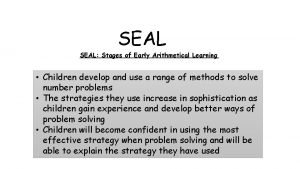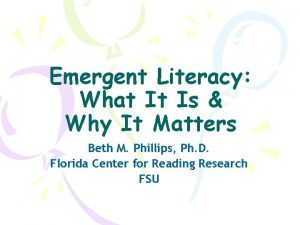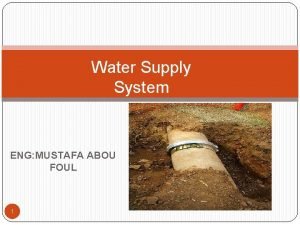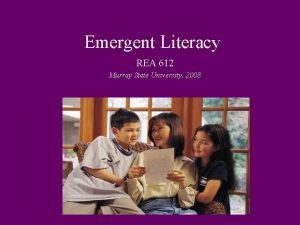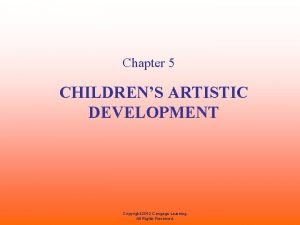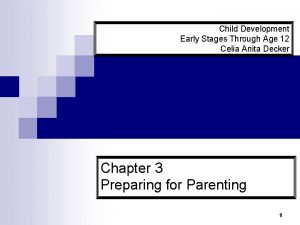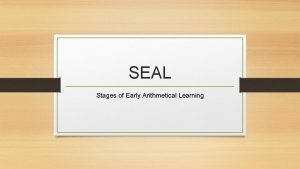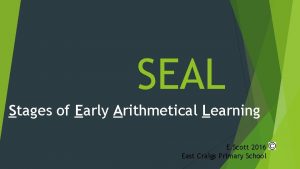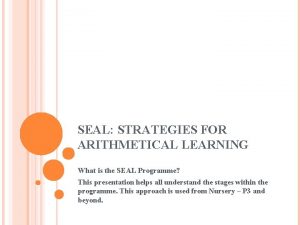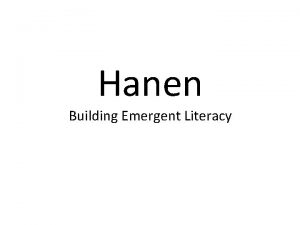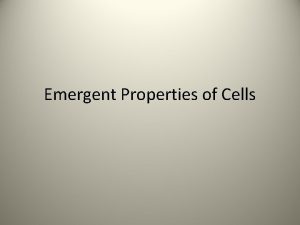SEAL STAGES OF EARLY ARITHMETICAL LEARNING THE EMERGENT










- Slides: 10

SEAL (STAGES OF EARLY ARITHMETICAL LEARNING)

THE EMERGENT CHILD At this stage the child: Attempts to count May not understand all counting tasks (social counter? ) May not know all the number words. May not be able to coordinate number words with items. May not have the organisational skills

THE PERCEPTUAL CHILD At this stage the child : Can count perceived items May involve seeing, hearing or feeling items May create perceptual replacements for abstract problems

TIME TO THINK AND DISCUSS … Can you recognise children in your nursery in these descriptions? What are the strengths and challenges of what you currently offer these children?

SEAL LEARNING AND TEACHING Teaching progressions give clear, small-stepped learning and teaching experiences to move forward a child’s understanding of number The emergent and perceptual progressions cover the number and number processes outcomes (MNU 0 -02 a and MNU 0 -03 a) at early level. Best advice is to start all children at emergent (some will progress quicker than others)

LEARNING AND TEACHING – WHAT? (FIVE KEY STRANDS IN TEACHING NUMBER) Counting Numerals Number Structures Addition and Subtraction Multiplication and Division (from perceptual only)

5. 1 NUMBER WORD SEQUENCES FROM 1 TO 20 Forward Number Word Sequences (FNWSs) Backward Number Word Sequences (BNWSs) Number word after/before

5. 2 NUMERALS FROM 1 TO 10 Numeral Recognition (“Point to the number 12”) Numeral Identification(“What number is this? ”) Sequencing Numbers Numeral Tracks Numeral Rolls 30 25 13 11

5. 3 AND 5. 6 ADDITION/SUBTRACTION Counting items in one collection (“How many are there? ”) Establishing a collection of given numerosity (“Can you give me 7? ”) Counting items of two collections/rows Temporal Patterns and Sequences

5. 4 AND 5. 5 Spatial Patterns Finger Patterns NUMBER STRUCTURES
 Stages of early arithmetical learning
Stages of early arithmetical learning Stages of early arithmetical learning
Stages of early arithmetical learning Early emergent literacy
Early emergent literacy Incremental increase method
Incremental increase method Rea612
Rea612 Early cpr and early defibrillation can: *
Early cpr and early defibrillation can: * Cuadro comparativo de e-learning b-learning y m-learning
Cuadro comparativo de e-learning b-learning y m-learning Physical development for early adulthood
Physical development for early adulthood Theories of child art development
Theories of child art development Child development early stages through age 12
Child development early stages through age 12 Emergent game technologies
Emergent game technologies

